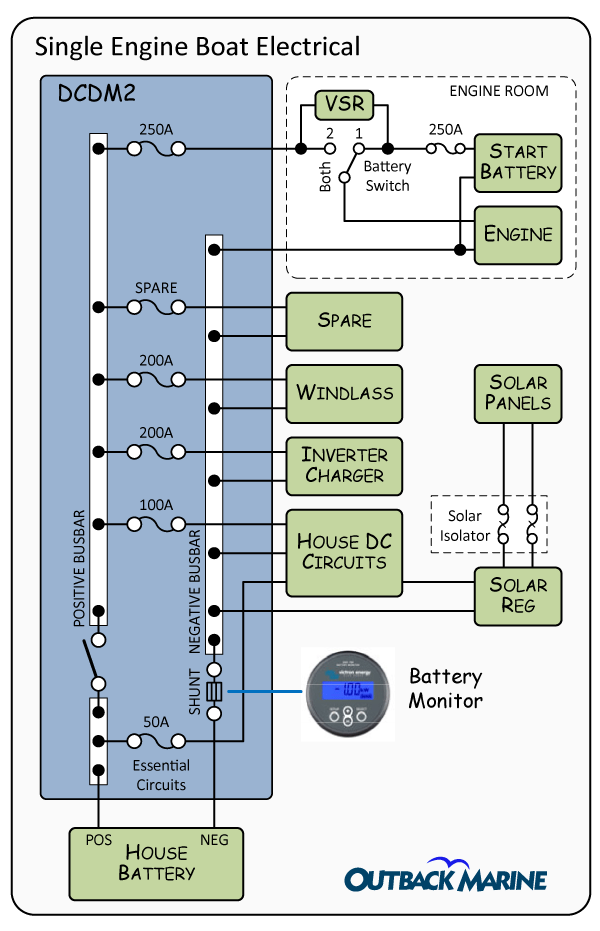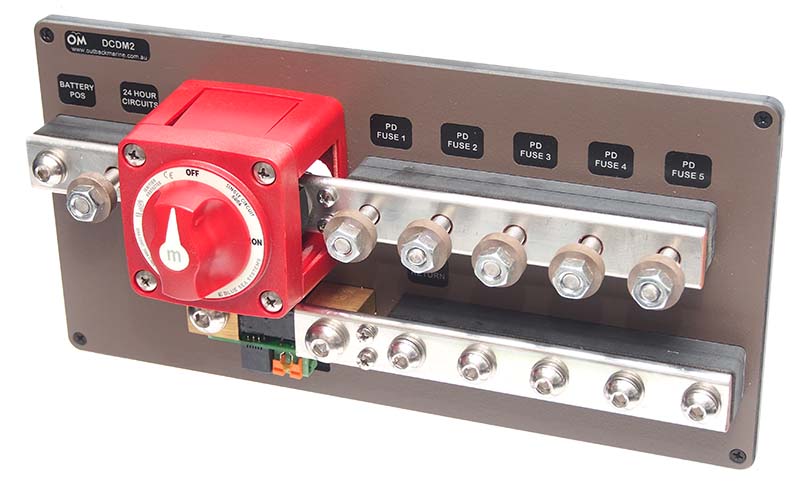Fundamental Boat Electrical System Design
Maybe you're looking at installing an inverter charger and don’t know where to start. Or the batteries are in a sad state and the charging system needs to be upgraded. Chances are that the core of the electrical system is just not up to scratch.
This article is applicable to both power and sailboats where the engine starter battery is in or near the engine room/compartment. The house battery can be located some metres from the engine/start battery.
Heavy DC wiring should be well organised, and all circuits must be protected from an overload situation to avoid fire risk. Outback Marine have now developed a simplified wiring system using our latest DCDM2 DC Distribution Board.
The DCD board works as the wiring hub of all the heavy DC circuits. It provides mounting points for all cables, a battery switch, a fused busbar system, a ground busbar and a mounting location for the Victron BMV battery monitor shunt.
The neighbouring circuit illustrates a system that incorporates the DCD board into the new boat wiring. With this product, all the old wiring is best ripped out and new wiring put in place. Shown is a single-engine setup however a dual engine setup simply adds another engine circuit to the system.
DCDM2 DC Distribution Board
House Battery System
In this case, the house batteries are a pair of AGM Deep Cycle Batteries. They are capable of delivering full cycles to the vessel loads and can also act as a backup battery to crank the engine in case of a starter battery failure.
The positive connects to a battery switch mounted on the DCD board and the negative connects to the battery monitor shunt (which measures net current in and out of the house battery).
Battery Monitor
Understanding the battery state of charge (SOC) is essential for good battery management. For this, we use a BMV-712 Battery Monitor which includes a Bluetooth interface to use with the free Victron Connect smartphone App. The DCD board has a location for mounting the battery monitor shunt. Note that only one side of the shunt connects to the battery negative terminal.
Inverter Charger
The inverter charger will provide AC power when the vessel is away from the dock. At the dock, it will act as the battery charger. The size of the inverter charger depends primarily on the simultaneous power draw of any AC appliances. For example, a system capable of powering an electric kettle (2,200-watts) would use a Victron Multiplus 12/3000 product. The size of the inverter charger may also dictate the house battery capacity.
The Inverter charger DC power is sourced from a Terminal Fuse mounted on the positive busbar of the DCD board and the ground return connects to the negative busbar. The recommended fuse size will be determined by the inverter charger being used. The practice to provide an Isolation Switch in the positive lead near the inverter charger if it is not located in the immediate vicinity of the main battery switch on the DCD board is recommended.
House Circuit Breaker Panel
Circuit breakers on this panel feed power to most DC consumer devices on the vessel. When the main battery switch is turned off, power is removed from all circuits connected to it. House panel power is sourced from a fuse on the positive busbar.
Essential circuits (such as bilge pumps) are those that require power on a 24-hour a day basis irrespective of the main battery switch being turned on or off. To realise this, a section of the house panel can be powered directly from the battery via a fuse mounted on the battery side of the battery switch.
Solar power can also be considered as an essential circuit so that solar battery charging can continue even when the main battery switch is turned off. A master essential circuit breaker must be used to provide full battery isolation in case of an emergency.
Solar Panels
A Solar Panel Controller is connected to the vessel essential circuit system via a circuit breaker on the house panel. To meet electrical standards, a two-pole isolator is required between the solar panels and the controller.
An alternative arrangement is to connect the solar controller to the main power bus that is controlled by the battery switch. In this case, the battery switch would need to be left on for solar charging. The advantage is that the start battery charge will be maintained by the VSR relays.
Windlass
The Anchor Winch can receive power either directly from a fuse on the DCD positive bus or from a circuit breaker mounted on the house panel.
Engine Connection
A connection to the propulsion engine is required for house battery charging and as a backup for engine starting from the house battery in case of start battery failure. The connecting cables must be sized according to the cable length and current.
A “1-2-Off” Battery Switch selects either the start battery or house battery for engine cranking. It is normally in the “1” position for the start battery when the boat is in use and the “off” position when the vessel is laid up. If the start battery fails to start the engine, position “2” can be used to connect the house battery for charging. Alternatively, a “1-2-both-off” Battery Switch has the capability of combining both the house and start batteries for engine cranking and battery charging, however care must be taken not to leave it in the “both” position.
A VSR (Voltage Sensitive Relay or Battery Combiner) will automatically connect the house battery and start battery to allow house battery charging when the engine is running, It will automatically disconnect when the engine is stopped to avoid discharge of the start battery.
Your System
The two example systems listed below are related to power levels of the inverter charger. They outline the heavy DC requirements. Contact Outback marine for further guidance. We also offer a full schematic and consulting service at a time and materials rate if you require detail guidance.
Example System A – Smaller Power Inverter Charger
The table below lists the components suggested for a system that uses a smaller sized 1,200-VA inverter charger. Follow the links for each product page. Items of different capacity can be used as required. Some items will require double quantity for a dual engine setup. Please enquire at Outback Marine for any questions.
|
Item |
Qty |
1200 VA System |
|---|---|---|
|
House Batteries Bank (170-AH) |
1 |
|
|
Battery Monitor |
1 |
|
|
DC Distribution Board |
1 |
|
|
Inverter Charger (1,200 VA) |
1 |
|
|
Inverter Charger Isolator |
1 |
|
|
Inverter Charger Fuse (150-amp) |
1 |
|
|
House Circuit Breaker Panel |
1 |
Custom to order |
|
House Panel Fuse (100-amp) |
1 |
|
|
Windlass Fuse |
1 |
|
|
Solar Panels |
2 |
|
|
Solar Panel Controller |
1 |
|
|
Solar Panel Isolator |
1 |
|
|
Essential Circuits Fuse |
1 |
|
|
Engine Fuses |
1/2 |
|
|
Battery Combiners/VSR |
1/2 |
|
|
Start Battery Switches |
1/2 |
|
|
Start Batteries |
1/2 |
Example System B – Medium Power Inverter Charger
The table below lists the components suggested for a system that uses a medium-sized 3,000-VA inverter charger. Follow the links for each product page. Items of different capacity can be used as required. Some items will require double quantity for a dual engine setup. Please enquire at Outback Marine for any questions.
|
Item |
Qty |
1200 VA System |
|---|---|---|
|
House Batteries Bank (340-AH) |
2 |
|
|
Battery Monitor |
1 |
|
|
DC Distribution Board |
1 |
|
|
Inverter Charger (1,200 VA) |
1 |
|
|
Inverter Charger Isolator |
1 |
|
|
Inverter Charger Fuse (150-amp) |
1 |
|
|
House Circuit Breaker Panel |
1 |
Custom to order |
|
House Panel Fuse (100-amp) |
1 |
|
|
Windlass Fuse |
1 |
|
|
Solar Panels |
3 |
|
|
Solar Panel Controller |
1 |
|
|
Solar Panel Isolator |
1 |
|
|
Essential Circuits Fuse |
1 |
|
|
Engine Fuses |
1/2 |
|
|
Battery Combiners/VSR |
1/2 |
|
|
Start Battery Switches |
1/2 |
|
|
Start Batteries |
1/2 |
Sort out your electrical system when upgrading to new batteries or an inverter charger.
- Heavy-duty bus bar system with battery switch and fuses
- Cross charge connection to vessel engine
- Easy to follow the schematic design








